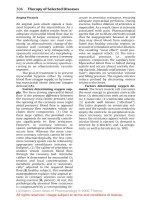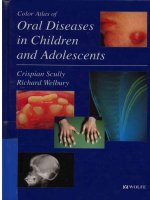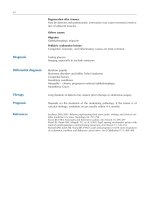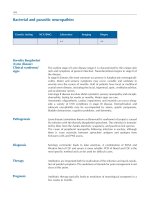Ebook Color atlas of oral diseases: Part 1
Bạn đang xem bản rút gọn của tài liệu. Xem và tải ngay bản đầy đủ của tài liệu tại đây (7.92 MB, 199 trang )
Color Atlas of Oral Diseases
George Laskaris,
D. D. S. , M. D.
Foreword by Gerald Shklar
Second edition, revised and expanded
555 illustrations
1994
Georg Thieme Verlag
Stuttgart . New York
Thieme Medical Publishers, Inc.
New York
ﺧﺪﻣﺎت ﻋﻠﻤﯽ ﺑﺎران
اوﻟﯿﻦ وﺗﻨﻬﺎ ﺗﻮﻟﯿﺪ ﮐﻨﻨﺪ ﮐﺘﺐ اﻟﮑﺘﺮوﻧﯿﮏ
اﯾﻦ ﮐﺘﺎب در ﺷﺮﮐﺖ ﺧﺪﻣﺎت ﻋﻠﻤﯽ ﺑﺎران ﺑﺼﻮرت اﻟﮑﺘﺮوﻧﯿﮏ ) (e-bookﺗﻬﯿﻪ ﺷﺪه
اﺳﺖ و ﺗﻤﺎم ﺣﻘﻮق اﯾﻦ اﺛﺮ در اﻧﺤﺼﺎر اﯾﻦ ﺷﺮﮐﺖ ﻣﯽ ﺑﺎﺷﺪ .
ﺷﺮﮐﺖ ﺑﺎران ﮐﺎﻣﻼ ﻣﺴﺘﻘﻞ ﺑﻮده و ﺑﻪ ﻫﯿﭻ ﻣﻮﺳﺴﻪ وﯾﺎ ﺷﺮﮐﺘﯽ واﺑﺴﺘﻪ ﻧﻤﯽ ﺑﺎﺷﺪ.
ﻫﺮﮔﻮﻧﻪ ﮐﭙﯽ ﺑﺮداری و ﯾﺎ ﺗﮑﺜﯿﺮ از اﯾﻦ ژورﻧﺎل ﻏﯿﺮ ﻗﺎﻧﻮﻧﯽ ﺑﻮده و ﻣﺘﺨﻠﻔﯿﻦ
ﺷﺪﯾﺪا ﻣﻮرد ﭘﯿﮕﯿﺮی و ﻣﺸﻤﻮل ﻗﻮاﻧﯿﻦ ﮐﺸﻮر اﯾﺮان ﻣﯽ ﺷﻮﻧﺪ.
ﺑﺮای درﯾﺎﻓﺖ ﻟﯿﺴﺖ ﮐﺘﺐ و ﻣﺠﻼت و ﺧﺮﯾﺪ ﻣﺴﺘﻘﯿﻢ ﺑﺎ ﻣﺎ
ﺗﻤﺎس ﺑﮕﯿﺮﯾﺪ.
ﺗﻬﺮان ص پ 14515-765ﺗﻠﻔﻦ 4311689
iv
George Laskaris, D.D.S., M.D.
Associate Professor in Oral Medicine and Pathology,
Dental School, University of Athens.
Consultant in Oral Medicine,
Dept. of Dermatology, <
20-22 Ipsilandou St.
10676 Athens, Greece
Library of Congress Cataloging-in-Publication Data
Laskaris, George.
[ Enchromos atlas stomatologias. English]
Color atlas of oral diseases / George Laskaris ; foreword
by Gerald Shklar. -- 2nd ed., rev. and expanded.
p.
cm.
Includes bibliographical references and index.
ISBN 3-13-717002-8 (G. Thieme Verlag). -ISBN 0-86577-537-0 (Thieme Medical Publishers)
1. Mouth--Diseases--Atlases. §. Title.
[ DNLM: 1. Mouth Diseases--atlases. WU 17 L345e
1994]
RC815.L3713 1994
617.5'22'0222--dc20
DNLM/DLC
94-9767
for Library of Congress
CIP
Important Note: Medicine is an ever-changing science.
Research and clinical experience are continually broadening our knowledge, in particular our knowledge of
proper treatment and drug therapy. Insofar as this book
mentions any dosage or application, readers may rest
assured that the authors, editors and publishers have
made every effort to ensure that such references are
strictly in accordance with the state of knowledge at the
time of production of the book. Nevertheless, every
user is requested to carefully examine the manufacturers leaflets accompanying each drug to check on his
own responsibility whether the dosage schedules recommended therein or the contraindications stated by the
manufacturers differ from the statements made in the
present book. Such examination is particularly important with drugs which are either rarely used or have
been newly released on the market.
This atlas is based on the Greek edition:
Enchromos Atlas StomatologiasColor Atlas of Stomatology
Copyright © 1986 by George Laskaris, Athens, Greece.
Published by Litsas Medical Publications,
Athens, Greece
Cover drawing: Renate Stockinger
Some of the product names, patents and registered
designs referred to in this book are in fact registered
trademarks or proprietary names even though specific
reference to this fact is not always made in the text.
Therefore, the appearance of a name without designation as proprietary is not to be construed as a representation by the publishers that it is in the public
domain.
©1988,1994 Georg Thieme Verlag, RudigerstraBe 14,
70469 Stuttgart, Germany
Thieme Medical Publishers, Inc.,
381 Park Avenue South, New York, N. Y. 10016
This book, including all parts thereof, is legally protected by copyright. Any use, exploitation or commercialization outside the narrow limits set by copyright legislation, without the publisher's consent, is illegal and liable
to prosecution. This applies in particular to photostat
reproduction, copying, mimeographing or duplication
of any kind, translating, preparation of microfilms, and
electronic data processing and storage.
ist Italian edition 1991
1st French edition 1989
Typesetting by Druckhaus Gotz GmbH,
71636 Ludwigsburg
(System 5, Linotron 202)
Printed in Germany by K. Grammlich, GmbH
ISBN 3-13-717002-8 (Georg Thieme Verlag, Stuttgart)
ISBN 0-86577-537-0 (Thieme Medical Publishers, Inc.,
New York)
1
2
3
4
5
6
V
Foreword
It is a distinct pleasure to see Dr. George Laskaris'
excellent Atlas of Oral Diseases come out in an
English edition. Dr. Laskaris' knowledge, background, and wealth of experience in the disciplines of oral medicine and oral pathology have
been well known to those of us in the field. His
highly respected research on autoimmune diseases
of the mouth has appeared in many English language journals, and it is fitting that his extensive
experience with oral diseases is now made available to the English-speaking world. This Atlas has
impressed even those of us who could not read the
original Greek, by the excellence of the color
illustrations and the broad range of diseases
covered. The English text now offers a brief but
authoritative discussion of each condition.
M.S.
Charles A. Brackett Professor of Oral Pathology
and Head of the Department of Oral Medicine
and Oral Pathology,
Harvard School of Dental Medicine,
Boston, Massachusetts
GERALD SHKLAB, D.D.S.,
VI
Preface to the Second Edition
The second edition of the Color Atlas of Oral
Diseases is enlarged and revised to keep pace with
current concepts and changes in the field of Oral
Medicine. New chapters and illustrations have
been included and the text of the first edition has
been modified on several occasions.
Two new chapters on HIV infections and AIDS
and renal diseases have been added.
Sixty-four illustrations of lesions and clinical
entities affecting the oral cavity, not published in
the first edition, are now included.
Nineteen new illustrations of diseases published in the first edition have been added to
broaden the spectrum of clinical presentation of
these entities.
Twenty-three illustrations have been replaced
by new, higher quality, more representative ones.
Three hundred and eighty-eight references
have been added.
I hope that the revised and enlarged second
edition of the Atlas is an improvement, and that it
will be as useful as the first edition to all of those
who are involved in the field of oral medicine.
Athens, 1994
GEORGE LASKARIS, D.D.S., M.D.
VII
Preface to the First Edition
Oral medicine is a rapidly growing clinical specialty encompassing the diagnosis and treatment
of patients with a wide spectrum of disorders
involving the oral cavity.
To achieve the optimum goals, oral medical
clinicians have to broaden their knowledge bases
and practice their clinical skills.
When 1 first started to work in this field 20
years ago, I could not imagine the variety of
disorders that affect the oral cavity, including
genetic diseases, infections, cancers, blood diseases, skin diseases, endocrine and metabolic disorders, autoimmune and rheumatologic diseases,
local lesions, to name a few. Fortunately, the oral
cavity is accessible to visual examination, and I
have attempted to record oral lesions in color
slides. During my career as a stomatologist, I have
collected more than 25,000 clinical color slides
that encompass a broad spectrum of common and
rare oral diseases. The most representative and
educationally useful illustrations have been used
in this Atlas. Almost all color slides have been
taken by me with a Nikon-Medical camera.
This book is the distillation of my clinical experience and is intended to aid primarily the practicing dentist, the specialist in oral medicine, the
oral pathologist and surgeon, the dermatologist,
and otorhinolaryngologist to solve the diagnostic
problems posed by oral diseases. It can also be
valuable to dental and medical students, general
internists, pediatricians, and other medical
specialists.
This book is not a complete reference work of
oral medicine and should be used in conjunction
with current textbooks and articles regarding
recommendations on treatment and new diagnostic techniques that are beyond its scope.
The material of the Atlas is divided into 33
chapters. Each entity is accompanied by color
plates and a description of the clinical features,
differential diagnosis, helpful laboratory tests, and
a brief statement on treatment.
Selective bibliography and index are included.
I hope that the Atlas will serve as a comprehensive pictorial guide for diagnostic problems in the
mouth and it will find its way in the places where
the battle against oral diseases is waged daily, that
is dental schools, hospitals, and private practice
offices.
Athens, 1988
GEORGE LASKARIS, D.D.S., M.D.
VIII
Acknowledgements
My deep appreciation is due to my patients, who
taught me so much, and to all of the Greek
dentists and physicians who have contributed by
referring their patients to me through the years.
My gratitude is extended to the late Professor
of Dermatology, John Capetanakis, and the current Professor of Dermatology and Head of the
Department of Dermatology, University of
Athens, "A. Syngros" Hospital, John Stratigos,
for their constant encouragement in my endeavors.
I am also indebted to Associate Professor of
Dermatology Antony Vareltzidis, who has greatly
helped me to broaden my knowledge in the field
of dermatology.
My sincere thanks are extended to the scientific
staff of "A.Syngros" Hospital, Department of
Dermatology, University of Athens, for their willing and prompt help during the 23 years of our
cooperation.
I am particularly grateful to Stathis S.
Papavasiliou, M.D., for his efforts and comments
on the translation of the Greek edition of this
book into English and text contributions in the
chapter of endocrine diseases.
My deepest gratitude is due to Professor Crispian Scully, Department of Oral Medicine and
Surgery, University of Bristol, England, and Professor Gerald Shklar, Department of Oral
Medicine and Pathology, Harvard School of Den-
tal Medicine, United States, both of whom read
the manuscript of the first edition. Their suggestions and criticisms have been gratefully received
and indeed improved the text considerably.
Finally, I wish to thank my colleagues at the
Department of Oral Medicine and Pathology of
the Dental School, University of Athens, with
whom I have worked closely for more than 25
years. In particular I wish to thank Dr. Alexandra
Sklavounou, Dr. Panagiota Economopoulou, and
Dr. Eleana Stufi for their assistance in the preparation of the first edition of the Atlas.
I am especially indebted to Dr. Stathis S.
Papavasiliou and Professor Crispian Scully for
their critical review of the text of second edition.
I thank the following colleagues for permission
to use their color plates: Dr. Robert Gorlin
(USA) for Figure 46, Dr. Karpathios (Greece) for
Figure 358, Dr. Andreas Katsabas (Greece) for
Figure 363, Dr. Nikos Lygidakis (Greece) for
Figure 67, Dr. Adeyeni Mosadomi (Nigeria) for
Figure 490, Dr. Crispian Scully (England) for
Figure 278, Dr. Gerald Shklar (USA) for Figures
277, 400, and Dr. Carl Witkop (USA) for Figure
21.
Last, but by no means least, I can never fully
repay all that I owe my wife and three children for
their constant patience, support, and encouragement.
ix
Contents
1. Normal Anatomic Variants
. . . . . . . . .
2
Linea Alba ......................
Normal Oral Pigmentation ............
Leukoedema ....................
2
2
2
2. Developmental Anomalies ..........
4
Fordyce's Granules . . . . . . . . . . . . . . . .
Oral Hair .......................
Congenital Lip Pits .................
Ankyloglossia ....................
Cleft Lip . . . . . . . . . . . . . . . . . . . . . . .
Cleft Palate . . . . . . . . . . . . . . . . . . . . .
Bifid Tongue . . . . . . . . . . . . . . . . . . . .
Double Lip ......................
Torus Palatinus . . . . . . . . . . . . . . . . . . .
Torus Mandibularis . . . . . . . . . . . . . . . .
Multiple Exostoses .................
Fibrous Developmental Malformation . . . .
Facial Hemiatrophy . . . . . . . . . . . . . . . .
Masseteric Hypertrophy . . . . . . . . . . . . .
4
4
4
6
6
6
8
8
8
10
10
10
12
12
3. Genetic Diseases ................
14
White Sponge Nevus . . . . . . . . . . . . . . . 14
Hereditary Benign Intraepithelial
Dyskeratosis ..................... 14
Gingival Fibromatosis ...............
14
Pachyonychia Congenita ............. 16
Dyskeratosis Congenita ..............
16
Hypohidrotic Ectodermal Dysplasia ......
18
Focal Palmoplantar and Oral Mucosa
Hyperkeratosis Syndrome . . . . . . . . . . . . 18
Papillon-Lefevre Syndrome . . . . . . . . . . . 20
Benign Acanthosis Nigricans . . . . . . . . . . 22
Dyskeratosis Follicularis . . . . . . . . . . . . . 22
Familial Benign Pemphigus . . . . . . . . . . . 24
Epidermolysis Bullosa . . . . . . . . . . . . . . 24
Neurofibromatosis ................. 26
Chondroectodermal Dysplasia . . . . . . . . . 28
Hereditary Hemorrhagic Telangiectasia . . . 28
Peutz-Jeghers Syndrome .............
28
Gardner's Syndrome . . . . . . . . . . . . . . .
Maffucci's Syndrome . . . . . . . . . . . . . . .
Tuberous Sclerosis .................
Sturge-Weber Syndrome . . . . . . . . . . . .
Klippel-Trenaunay-Weber Syndrome ...
Cowden's Disease . . . . . . . . . . . . . . . . .
Cleidocranial Dysplasia ..............
Oro-Facial Digital Syndrome . . . . . . . . . .
Focal Dermal Hypoplasia . . . . . . . . . . . .
Incontinentia Pigmenti . . . . . . . . . . . . . .
Ehlers-Danlos Syndrome ............
Marfan's Syndrome . . . . . . . . . . . . . . . .
Down's Syndrome . . . . . . . . . . . . . . . . .
30
30
32
34
34
36
36
38
38
40
40
42
42
4. Mechanical Injuries
44
. . . . . . . . . . . . . .
Traumatic Ulcer . . . . . . . . . . . . . . . . . . 44
Traumatic Bulla . . . . . . . . . . . . . . . . . . 46
Traumatic Hematoma ............... 46
Chronic Biting . . . . . . . . . . . . . . . . . . . 46
Toothbrush Trauma ................
46
Factitious Trauma . . . . . . . . . . . . . . . . . 48
Fellatio ........................ 48
Lingual Frenum Ulcer After Cunnilingus . . 48
Cotton Roll Stomatitis . . . . . . . . . . . . . . 48
Denture Stomatitis ................. 50
Epulis Fissuratum . . . . . . . . . . . . . . . . . 50
Papillary Hyperplasia of the Palate . . . . . . 50
Hyperplasia due to Negative Pressure ..... 52
Atrophy of the Maxillary Alveolar Ridge . . 52
Foreign Body Reaction . . . . . . . . . . . . . . 52
Palatal Necrosis due to Injection . . . . . . . . 54
Eosinophilic Ulcer . . . . . . . . . . . . . . . . . 54
5. Oral Lesions due to Chemical Agents ...
56
Phenol Burn . . . . . . . . . . . . . . . . . . . . .
Trichloroacetic Acid Burn . . . . . . . . . . . .
Eugenol Burn ....................
Aspirin Burn . . . . . . . . . . . . . . . . . . . .
Iodine Burn . . . . . . . . . . . . . . . . . . . . .
Alcohol Burn . . . . . . . . . . . . . . . . . . . .
Acrylic Resin Burn .................
56
56
56
58
58
58
58
x
Contents
Sodium Perborate Burn ..............
Silver Nitrate Burn .................
Sodium Hypochlorite Burn . . . . . . . . . . .
Paraformaldehyde Burn . . . . . . . . . . . . .
Chlorine Compounds Burn . . . . . . . . . . .
Agricultural Chemical Agents Burn ......
60
60
60
60
62
62
6. Oral Lesions due to Smoking and Heat . .
64
Nicotinic Stomatitis . . . . . . . . . . . . . . . .
Palatal Erosions due to Smoking . . . . . . . .
Cigarette Smoker's Lip Lesion . . . . . . . . .
Smoker's Melanosis . . . . . . . . . . . . . . . .
Thermal Burn ....................
64
64
66
66
66
7. Oral Lesions due to Drugs . . . . . . . . . .
68
Gold-induced Stomatitis . . . . . . . . . . . . .
Antibiotic-induced Stomatitis ..........
Stomatitis Medicamentosa ............
Ulcerations due to Methotrexate ........
Ulceration due to Azathioprine .........
Penicillamine-induced Oral Lesions ......
Phenytoin-induced Gingival Hyperplasia ...
Cyclosporine-induced Gingival Hyperplasia .
Nifedipine-induced Gingival Hyperplasia . .
Angioneurotic Edema ...............
Pigmentation due to Antimalarials .......
Pigmentation due to Azidothymidine .....
Cheilitis due to Retinoids .............
68
68
68
70
70
70
72
72
72
74
74
74
76
. . . . . . . . . .
77
8. Metal and Other Deposits
Amalgam Tattoo . . . . . . . . . . . . . . . . . . 77
Bismuth Deposition . . . . . . . . . . . . . . . . 78
Phleboliths ...................... 78
Materia Alba of the Attached Gingiva . . . . 78
9. Radiation-Induced Injuries
. . . . . . . . .
80
10. Allergy to Chemical Agents Applied
Locally ..................... 83
Allergic Stomatitis due to Acrylic Resin . . .
Allergic Stomatitis due to Eugenol .......
83
84
11. Periodontal Diseases .............
85
Gingivitis ....................... 85
Periodontitis .....................
86
Juvenile Periodontitis ............... 86
Periodontal Abscess ................ 86
Periodontal Fistula .................
88
Gingivitis and Mouth Breathing . . . . . . . . 88
Plasma Cell Gingivitis ...............
Desquamative Gingivitis .............
88
90
12. Diseases of the Tongue
92
. . . . . . . . . . .
Median Rhomboid Glossitis ...........
92
Geographic Tongue . . . . . . . . . . . . . . . . 92
Fissured Tongue . . . . . . . . . . . . . . . . . . 94
Hairy Tongue . . . . . . . . . . . . . . . . . . . . 94
Furred Tongue . . . . . . . . . . . . . . . . . . . 96
Plasma Cell Glossitis . . . . . . . . . . . . . . . 96
Glossodynia ..................... 96
Crenated Tongue .................. 98
Hypertrophy of Foliate Papillae . . . . . . . . 98
Hypertrophy of Circumvallate Papillae ....
98
Hypertrophy of the Fungiform Papillae .... 100
Sublingual Varices . . . . . . . . . . . . . . . . . 100
13. Diseases of the Lips
. . . . . . . . . . . . . 102
Median Lip Fissure . . . . . . . . . . . . . . . .
Angular Cheilitis ..................
Actinic Cheilitis ...................
Exfoliative Cheilitis . . . . . . . . . . . . . . . .
Contact Cheilitis . . . . . . . . . . . . . . . . . .
Cheilitis Glandularis ................
Cheilitis Granulomatosa . . . . . . . . . . . . .
Plasma Cell Cheilitis ................
14. Soft-Tissue Cysts
102
102
102
104
104
104
106
106
. . . . . . . . . . . . . . 108
Mucocele ....................... 108
Ranula ........................ 108
Lymphoepithelial Cyst . . . . . . . . . . . . . . 110
Dermoid Cyst .................... 110
Eruption Cyst .................... 112
Gingival Cyst of the Newborn .......... 112
Gingival Cyst of the Adult . . . . . . . . . . . . 112
Palatine Papilla Cyst ................ 114
Nasolabial Cyst ................... 114
Thyroglossal Duct Cyst . . . . . . . . . . . . . . 114
15. Viral Infections
. . . . . . . . . . . . . . . . 116
Primary Herpetic Gingivostomatitis ...... 116
Secondary Herpetic Stomatitis . . . . . . . . . 116
Herpes Labialis ................... 118
Herpes Zoster .................... 118
Varicella ....................... 120
Herpangina ..................... 120
Acute Lymphonodular Pharyngitis . . . . . . 120
Hand-Foot-and-Mouth Disease ......... 122
Measles ........................ 122
Infectious Mononucleosis . . . . . . . . . . . . 124
Mumps ........................ 124
Contents
Verruca Vulgaris . . . . . . . . . . . . . . . . . .
Condyloma Acuminatum .............
Molluscum Contagiosum .............
Focal Epithelial Hyperplasia . . . . . . . . . .
124
126
126
128
16. HIV Infection and AIDS . . . . . . . . . . 129
Infections ....................... 130
Neoplasms ...................... 136
Neurologic Disturbances . . . . . . . . . . . . . 138
Lesions of Unknown Cause . . . . . . . . . . . 140
17. Bacterial Infections .............. 142
Necrotizing Ulcerative Gingivitis ........ 142
Necrotizing Ulcerative Stomatitis . . . . . . . 142
Cancrum Oris .................... 142
Streptococcal Gingivostomatitis . . . . . . . . 144
Erysipelas ...................... 144
Scarlet Fever . . . . . . . . . . . . . . . . . . . . 144
Oral Soft-Tissue Abscess . . . . . . . . . . . . 146
Peritonsillar Abscess . . . . . . . . . . . . . . . 146
Acute Suppurative Parotitis . . . . . . . . . . . 146
Acute Submandibular Sialadenitis ....... 148
Buccal Cellulitis . . . . . . . . . . . . . . . . . . 148
Klebsiella Infections ................ 148
Pseudomonas Infections . . . . . . . . . . . . . 150
Syphilis ........................ 150
Primary Syphilis . . . . . . . . . . . . . . . . . 150
Secondary Syphilis . . . . . . . . . . . . . . . 152
Late Syphilis . . . . . . . . . . . . . . . . . . . 154
Congenital Syphilis . . . . . . . . . . . . . . . . 156
Chancroid ...................... 158
Gonococcal Stomatitis . . . . . . . . . . . . . . 158
Tuberculosis ..................... 158
Lupus Vulgaris . . . . . . . . . . . . . . . . . . . 160
Leprosy ........................ 160
Actinomycosis ................... 162
18. Fungal Infections . . . . . . . . . . . . . . . 164
Candidosis ...................... 164
Primary Oral Candidosis . . . . . . . . . . . 164
Secondary Oral Candidosis .......... 168
Histoplasmosis ................... 170
North American Blastomycosis ......... 170
Paracoccidioidomycosis .............. 172
Mucormycosis .................... 172
19. Other Infections ................ 174
Cutaneous Leishmaniasis ............. 174
Sarcoidosis ...................... 174
Heerfordt's Syndrome . . . . . . . . . . . . . . 176
xi
20. Diseases with Possible
Immunopathogenesis ............ 177
Recurrent Aphthous Ulcers . . . . . . . . . . .
Minor Aphthous Ulcers . . . . . . . . . . . .
Major Aphthous Ulcers . . . . . . . . . . . .
Herpetiform Ulcers ...............
Behcet's Syndrome . . . . . . . . . . . . . . . .
Reiter's Syndrome .................
Wegener's Granulomatosis . . . . . . . . . . .
Lethal Midline Granuloma ............
Crohn's Disease . . . . . . . . . . . . . . . . . .
177
177
178
178
180
182
184
185
186
21. Autoimmune Diseases ............ 188
Discoid Lupus Erythematosus . . . . . . . . . 188
Systemic Lupus Erythematosus ......... 190
Scleroderma ..................... 190
Dermatomyositis .................. 192
Mixed Connective Tissue Disease . . . . . . . 194
Sjogren's Syndrome ................ 194
Benign Lymphoepithelial Lesion ........ 196
Primary Biliary Cirrhosis ............. 196
Lupoid Hepatitis . . . . . . . . . . . . . . . . . . 196
22. Skin Diseases
. . . . . . . . . . . . . . . . .
198
Erythema Multiforme ............... 198
Stevens-Johnson Syndrome . . . . . . . . . . 199
Toxic Epidermal Necrolysis . . . . . . . . . . . 200
Pemphigus ...................... 202
Pemphigus Vulgaris ............... 202
Pemphigus Vegetans . . . . . . . . . . . . . . 202
Pemphigus Foliaceus . . . . . . . . . . . . . . 204
Pemphigus Erythematosus . . . . . . . . . . 204
Juvenile Pemphigus Vulgaris . . . . . . . . . . 204
Paraneoplastic Pemphigus . . . . . . . . . . . . 206
Cicatricial Pemphigoid . . . . . . . . . . . . . . 207
Childhood Cicatricial Pemphigoid ....... 210
Linear Immunoglobulin A Disease . . . . . . 210
Bullous Pemphigoid ................ 210
Dermatitis Herpetiformis . . . . . . . . . . . . 212
Epidermolysis Bullosa Acquisita ........ 214
Lichen Planus .................... 214
Psoriasis ....................... 218
Mucocutaneous Lymph Node Syndrome ... 220
Malignant Acanthosis Nigricans . . . . . . . . 220
Acrodermatitis Enteropathica . . . . . . . . . 222
Lip-Licking Dermatitis . . . . . . . . . . . . . . 222
Perioral Dermatitis . . . . . . . . . . . . . . . . 222
Warty Dyskeratoma ................ 224
Vitiligo ........................ 224
xii
Contents
. . . . . . . . . . . 226
29. Precancerous Lesions . . . . . . . . . . . . 258
Iron Deficiency Anemia . . . . . . . . . . . . . 226
Plummer-Vinson Syndrome . . . . . . . . . . 226
Pernicious Anemia ................. 226
Thalassemias .................... 228
Congenital Neutropenia . . . . . . . . . . . . . 228
Cyclic Neutropenia . . . . . . . . . . . . . . . . 228
Agranulocytosis .................. 230
Aplastic Anemia . . . . . . . . . . . . . . . . . . 232
Thrombocytopenic Purpura ........... 232
Myelodysplastic Syndrome ............ 232
Leukoplakia ..................... 258
Erythroplasia .................... 262
Candidal Leukoplakia ............... 264
23. Hematologic Disorders
24. Renal Diseases
Uremic Stomatitis
30. Precancerous Conditions .......... 265
Plummer-Vinson Syndrome . . . . . . . . . .
Atrophic Glossitis in Tertiary Syphilis .....
Submucous Fibrosis . . . . . . . . . . . . . . . .
Epidermolysis Bullosa Dystrophica . . . . . .
Xeroderma Pigmentosum . . . . . . . . . . . .
Lichen Planus . . . . . . . . . . . . . . . . . . . .
265
266
266
268
268
268
. . . . . . . . . . . . . . . . 234
. . . . . . . . . . . . . . . . . 234
25. Metabolic Diseases .............. 236
Amyloidosis ..................... 236
Lipoid Proteinosis . . . . . . . . . . . . . . . . . 238
Glycogen Storage Disease Type lb . . . . . . 240
Xanthomas ...................... 240
Porphyrias ...................... 242
Hemochromatosis ................. 242
Cystic Fibrosis .................... 244
Histiocytosis X . . . . . . . . . . . . . . . . . . . 244
26. Nutritional Disorders
. . . . . . . . . . . . 247
Pellagra ........................ 247
Ariboflavinosis ................... 248
Scurvy ......................... 248
Protein Deficiency ................. 248
27. Endocrine Diseases
31. Malignant Neoplasms
. . . . . . . . . . . . 270
Squamous Cell Carcinoma ............ 270
Verrucous Carcinoma ............... 274
Adenoid Squamous Cell Carcinoma ...... 276
Spindle Cell Carcinoma .............. 276
Lymphoepithelial Carcinoma .......... 276
Basal Cell Carcinoma . . . . . . . . . . . . . . . 278
Acinic Cell Carcinoma . . . . . . . . . . . . . . 278
Mucoepidermoid Carcinoma . . . . . . . . . . 280
Adenoid Cystic Carcinoma . . . . . . . . . . . 280
Malignant Pleomorphic Adenoma ....... 282
Adenocarcinoma .................. 282
Clear Cell Adenocarcinoma ........... 282
Polymorphous Low-Grade Adenocarcinoma 284
Fibrosarcoma .................... 284
Kaposi's Sarcoma . . . . . . . . . . . . . . . . . 284
Malignant Fibrous Histiocytoma ........ 286
Hemangioendothelioma ............. 286
Hemangiopericytoma ............... 286
Malignant Melanoma . . . . . . . . . . . . . . . 288
Chondrosarcoma .................. 288
Osteosarcoma .................... 290
Metastatic Tumors ................. 290
. . . . . . . . . . . . . 250
Diabetes Mellitus .................. 250
AdrenocorticalInsufficiency .......... 250
Hypothyroidism .................. 250
Primary Hyperparathyroidism . . . . . . . . . 252
Sex Hormone Disorders . . . . . . . . . . . . . 252
Acromegaly ..................... 252
28. Diseases of the Peripheral Nervous
System ...................... 254
Hypoglossal Nerve Paralysis ........... 254
Peripheral Facial Nerve Paralysis ........ 254
Ipsilateral Masseter's Spasm ........... 256
Melkersson-Rosenthal Syndrome ....... 256
32. Malignancies of the Hematopoietic and
Lymphatic Tissues . . . . . . . . . . . . . . 293
Leukemias ...................... 293
Acute Leukemias . . . . . . . . . . . . . . . . 293
Chronic Leukemias ............... 293
Erythroleukemia .................. 296
Polycythemia Vera ................. 296
Hodgkin's Disease . . . . . . . . . . . . . . . . . 298
Non-Hodgkin's Lymphomas ........... 298
Burkitt's Lymphoma . . . . . . . . . . . . . . . 300
Mycosis Fungoides ................. 300
Macroglobulinemia ................ 302
Plasmacytoma of the Oral Mucosa ....... 302
Multiple Myeloma . . . . . . . . . . . . . . . . . 302
Contents
33. Benign Tumors
. . . . . . . . . . . . . . . . 304
Papilloma ...................... 304
Verrucous Hyperplasia . . . . . . . . . . . . . . 304
Keratoacanthoma ................. 306
Fibroma ....................... 306
Giant Cell Fibroma . . . . . . . . . . . . . . . . 306
Peripheral Ossifying Fibroma . . . . . . . . . . 308
Soft-Tissue Osteoma ....... . . . . . ... 308
Lipoma ................ . . . . . . . . 310
Myxoma ....................... 310
Neurofibroma .................... 310
Schwannoma .................... 312
Traumatic Neuroma ................ 312
Leiomyoma ..................... 312
Verruciform Xanthoma .............. 314
Granular Cell Tumor . . . . . . . . . . . . . . . 314
Benign Fibrous Histiocytoma .......... 314
Hemangioma .................... 316
Lymphangioma ................... 318
Cystic Hygroma ................... 318
Papillary Syringadenoma of the Lower Lip . . 320
Sebaceous Adenoma . . . . . . . . . . . . . . . 320
Cutaneous Horn . . . . . . . . . . . . . . . . . . 320
Freckles ........................ 322
Lentigo Simplex . . . . . . . . . . . . . . . . . . 322
Intramucosal Nevus . . . . . . . . . . . . . . . . 322
Junctional Nevus . . . . . . . . . . . . . . . . . . 324
Compound Nevus . . . . . . . . . . . . . . . . . 324
xiii
Blue Nevus ...................... 324
Nevus of Ota . . . . . . . . . . . . . . . . . . . . 326
Lentigo Maligna . . . . . . . . . . . . . . . . . . 326
Melanotic Neuroectodermal Tumor of
Infancy ........................ 328
Pleomorphic Adenoma .............. 328
Papillary Cystadenoma Lymphomatosum . . 330
34. Other Salivary Gland Disorders ...... 331
Necrotizing Sialometaplasia ........... 331
Sialolithiasis ..................... 332
Mikulicz's Syndrome . . . . . . . . . . . . . . . 332
Sialadenosis ..................... 332
Xerostomia ..................... 334
35. Tumor-like Lesions .............. 335
Pyogenic Granuloma . . . . . . . . . . . . . . . 335
Pregnancy Granuloma . . . . . . . . . . . . . . 336
Postextraction Granuloma ............ 336
Fistula Granuloma ................. 338
Peripheral Giant Cell Granuloma . . . . . . . 338
Congenital Epulis of the Newborn ....... 340
Selected Bibliography ............... 341
Index ......................... 363
This atlas is dedicated
to the memory of my father
and
to my family
2
1. Normal Anatomic Variants
Linea Alba
Leukoedema
Linea alba is a normal linear elevation of the
buccal mucosa extending from the corner of the
mouth to the third molars at the occlusal line.
Clinically, it presents as a bilateral linear elevation
with normal or slightly whitish color and normal
consistency on palpation (Fig. 1).
It occurs more often in obese persons. The oral
mucosa is slightly compressed and adjusts to the
shape of the occlusal line of the teeth.
Leukoedema is a normal anatomic variant of the
oral mucosa due to increased thickness of the
epithelium and intracellular edema of the malpighian layer. As a rule, it occurs bilaterally and
involves most of the buccal mucosa and rarely the
lips and tongue. Clinically, the mucosa has an
opalescent or grayish-white color with slight
wrinkling, which disappears if the mucosa is distended by pulling or stretching of the cheek
(Fig. 3). Leukoedema has normal consistency on
palpation, and it should not be confused with
leukoplakia or lichen planus.
Normal Oral Pigmentation
Melanin is a normal skin and oral mucosa pigment
produced by melanocytes. Increased melanin
deposition in the oral mucosa may occur in various
diseases. However, areas of dark discoloration
may often be a normal finding in black or darkskinned persons. However, the degree of pigmentation of skin and oral mucosa is not necessarily
significant. In healthy persons there may be clinically asymptomatic black or brown areas of varying size and distribution in the oral cavity, usually
on the gingiva, buccal mucosa, palate, and less
often on the tongue, floor of the mouth, and lips
(Fig. 2). The pigmentation is more prominent in
areas of pressure or friction and becomes more
intense with aging.
The differential diagnosis includes Addison's disease, pigmented nevus, melanoma, smoker's
melanosis, heavy metal deposition, lentigo
maligna, pigmentation caused by drugs, PeutzJeghers syndrome, Albright's syndrome, and von
Recklinghausen's disease.
1. Normal Anatomic Variants
Fig. 1. Linea alba.
Fig. 2. Normal pigmentation of the
gingiva.
Fig. 3. Leukoedema of the buccal
mucosa.
3
4
2. Developmental Anomalies
Fordyce's Granules
Laboratory test. Histopathologic examination
supports the clinical diagnosis.
Fordyce's granules are a developmental anomaly
characterized by collections of heterotopic sebaceous glands in the oral mucosa. Clinically, there
are many small, slightly raised whitish-yellow
spots that are well circumscribed and rarely
coalesce, forming plaques (Fig. 4). They occur
most often in the mucosal surface of the upper lip,
commissures, and the buccal mucosa adjacent to
the molar teeth in a symmetrical bilateral pattern.
They are a frequent finding in about 80% of
persons of both sexes. These granules are asymptomatic and come to the patient's attention by
chance. With advancing age, they may become
more prominent but should not be a cause for
concern.
Treatment. Surgical removal is recommended.
The differential diagnosis includes lichen planus,
candidosis, and leukoplakia.
Treatment. No treatment is required.
Oral Hair
Hair and hair follicles are extremely unusual
within the oral cavity. Only five cases have been
reported so far. There is no satisfactory explanation for the occurrence of oral hair although a
developmental anomaly is the most likely possibility. All reported patients have been white males.
The buccal mucosa, gingiva, and tongue are the
preferred areas of hair growth.
Oral hair presents as an asymptomatic black
hair 0.3-3.5 cm in length (Fig. 5). The patients
are usually anxious and nervous. The presence of
oral hair and hair follicles may offer an explanation for the rare occurrence of keratoacanthoma
intraorally.
The differential diagnosis should be made from
traumatically implanted hair and the presence of
hair in skin grafts after surgical procedures in the
oral cavity.
Congenital Lip Pits
Congenital lip pits represent a rare developmental
malformation that may occur alone or in combination with commissural pits, cleft lip, or cleft
palate. Clinically, they present as bilateral or
unilateral depressions at the vermilion border of
the lower lip (Fig. 6). A small amount of mucous
secretion may accumulate at the depth of the pit.
The lip may be enlarged and swollen.
Treatment of choice is surgical excision, but only
for esthetic purposes.
2. Developmental Anomalies
Fig. 4. Fordyce's granules in the
buccal mucosa.
Fig. 5. Black hair on the tip of the
tongue (arrow).
Fig. 6. Congenital lip pits.
5
6
2. Developmental Anomalies
Fig. 7. Ankyloglossia.
Ankyloglossia
Cleft Palate
Ankyloglossia, or tongue-tie, is a rare developmental disturbance in which the lingual frenum is
short or is attached close to the tip of the tongue
(Fig. 7). In these cases the frenum is often thick
and fibrous. Rarely, the condition may occur as a
result of fusion between the tongue and the floor
of the mouth or the alveolar mucosa. The malformation may cause speech difficulties.
Cleft palate is a developmental malformation due
to failure of the two embryonic palatal processes
to fuse. The cause remains unknown, although
heredity may play a role. Clinically, the patients
exhibit a defect at the midline of the palate that
may vary in severity (Fig. 9). Bifid uvula represents a minor expression of cleft palate and may
be seen alone or in combination with more severe
malformations (Fig. 10).
Cleft palate may occur alone or in combination
with cleft lip. The incidence of cleft palate alone
varies between 0.29 and 0.56 per 1000 births. It
may occur in the hard or soft palate or both.
Serious speech, feeding, and psychologic problems may occur.
Treatment. Surgical clipping of the frenum corrects the problem.
Cleft Lip
Cleft lip is a developmental malformation that
usually involves the upper lip and very rarely the
lower lip (Fig. 8). It frequently coexists with cleft
palate and it rarely occurs alone. The incidence of
cleft lip alone or in combination with cleft palate
varies from 0.52 to 1.34 per 1000 births.
The disorder may be unilateral or bilateral,
complete or incomplete.
Treatment. Plastic surgery as early as possible
corrects the esthetic and functional problems.
Treatment. Early surgical correction is recommended.
2. Developmental Anomalies
Fig. 8. Cleft lip.
Fig. 9. Cleft palate.
Fig. 10. Bifid uvula.
7
8
2. Developmental Anomalies
Bifid Tongue
Torus Palatinus
Bifid tongue is a rare developmental malformation that may appear in complete or incomplete
form. The incomplete form is manifested as a
deep furrow along the midline of the dorsum of
the tongue or as a double ending of the tip of the
tongue (Fig. 11). Usually, it is an asymptomatic
disorder requiring no therapy. It may coexist with
the oro-facial digital syndrome.
Torus palatinus is a developmental malformation
of unknown cause. It is a bony exostosis occurring
along the midline of the hard palate. The incidence of torus palatinus is about 20% and appears
in the third decade of life, but it also may occur at
any age. The size of the exostosis varies, and the
shape may be spindlelike, lobular, nodular, or
even completely irregular (Fig. 13). The exostosis
is benign and consists of bony tissue covered with
normal mucosa, although it may become ulcerated
if traumatized. Because of its slow growth, the
lesion causes no symptoms, and it is usually an
incidental finding during physical examination.
Double Lip
Double lip is a malformation characterized by a
protruding horizontal fold of the inner surface of
the upper lip (Fig. 12). It may be congenital, but it
can also occur as a result of trauma. The abnormality becomes prominent during speech or smiling. Frequently, it may be part of Ascher's syndrome.
Treatment. Surgical correction may be attempted
for esthetic reasons only.
Treatment. No treatment is needed, but problems
may be anticipated if a total or partial denture is
required.
2. Developmental Anomalies
Fig. 11. Bifid tongue.
Fig. 12. Double lip.
Fig. 13. Torus palatinus.
9
10
2. Developmental Anomalies
Torus Mandibularis
Fibrous Developmental Malformation
Torus mandibularis is an exostosis covered with
normal mucosa that appears on the lingual surfaces of the mandible, usually in the area adjacent
to the bicuspids (Fig. 14). The incidence of torus
mandibularis is about 6%. Bilateral exostoses
occur in 80% of the cases.
Clinically, it is an asymptomatic growth that
varies in size and shape.
Treatment. Surgical removal of torus mandibularis is not indicated, but difficulties may be
encountered if a denture has to be constructed.
Fibrous developmental malformation is a rare
developmental disorder consisting of fibrous overgrowth that usually occurs on the maxillary alveol ar tuberosity. It appears as a bilateral symmetrical painless mass with a smooth surface, firm to
palpation, and normal or pale color (Fig. 16).
Commonly, the malformation develops during the
eruption of the teeth and may cover their crowns.
The mass is firmly attached to the underlying bone
but on occasion may be movable.
The classic sites of development are the maxillary alveolar tuberosity region, but rarely it may
also appear in the retromolar region of the mandible and on the entire attached gingiva.
Treatment. Surgical excision is required if
mechanical problems exist.
Multiple Exostoses
Multiple exostoses are rare and may occur on the
buccal surface of the maxilla and the mandible.
Clinically, they appear as multiple asymptomatic
small nodular, bony elevations below the muccolabial fold covered with normal mucosa (Fig. 15).
The cause is unknown and the lesions are benign, requiring no therapy.
Problems may be encountered during denture
preparation.
2. Developmental Anomalies
Fig. 14. Torus mandibularis.
Fig. 15. Multiple exostoses.
Fig. 16. Fibrous developmental
malformation of the maxillary
tuberosities.
11
12
2. Developmental Anomalies
Facial Hemiatrophy
Masseteric Hypertrophy
Facial hemiatrophy, or Parry-Romberg syndrome,
is a developmental disorder of unknown cause
characterized by unilateral atrophy of the facial
tissues.
Sporadic hereditary cases have been described.
The disorder becomes apparent in childhood and
girls are affected more frequently than boys in a
ratio of 3:2. In addition to facial hemiatrophy,
epilepsy, trigeminal neuralgia, eye, hair, and
sweat gland disorders may occur. The lipocytes on
one side of the face disappear first, followed by
skin, muscle, cartilage, and bone atrophy. Clinically, the affected side appears atrophic and the
skin is wrinkled and shriveled with hyperpigmentation occasionally (Fig. 17).
Hemiatrophy of the tongue and the lips are the
most common oral manifestations (Fig. 18). Jaw
and teeth disorders on the affected side may also
occur.
Masseteric hypertrophy may be either congenital
or functional as a result of an increased muscle
function, bruxism, or habitual overuse of the masseters during mastication. The hypertrophy may
be bilateral or unilateral. Clinically, masseteric
hypertrophy appears as a swelling over the
ascending ramus of the mandible, which characteristically becomes more prominent and firm
when the patient clenches the teeth (Fig. 19).
The differential diagnosis includes true lipodystrophy, atrophy secondary to facial paralysis, facial
hemihypertrophy, unilateral masseteric hypertrophy, and scleroderma.
Treatment is plastic reconstruction.
The differential diagnosis includes Sjogren's,
Mikulicz's, and Heerfordt's syndromes, cellulitis,
facial hemihypertrophy, and neoplasms.
Treatment. No treatment is necessary.
2. Developmental Anomalies
Fig. 17. Hemiatrophy of the right side
of the face.
Fig. 18. Atrophy of the right side of
the tongue.
Fig. 19. Hypertrophy of the left
masseter.
13









